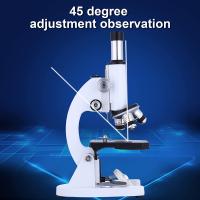Why Do Scientists Use Microscopes To Study Cells ?
Scientists use microscopes to study cells because cells are extremely small and cannot be seen with the naked eye. Microscopes allow scientists to magnify the cells, enabling them to observe and study their structure, function, and behavior in detail. By using microscopes, scientists can examine the different components of cells, such as the nucleus, cytoplasm, and organelles, and understand how they interact and contribute to the overall functioning of the cell. Microscopes also enable scientists to visualize cellular processes, such as cell division, movement, and communication, which are crucial for understanding the biology of organisms. Overall, microscopes are essential tools in cell biology, providing scientists with the ability to explore and unravel the complexities of cellular life.
1、 Magnification: Enhancing visibility of cellular structures for detailed examination.
Scientists use microscopes to study cells because they allow for the magnification of cellular structures, enhancing visibility for detailed examination. The use of microscopes enables scientists to observe and analyze cells at a level of detail that would not be possible with the naked eye. By magnifying the image, microscopes provide a clearer view of cellular components, such as organelles, membranes, and cytoplasm, allowing scientists to study their structure, function, and interactions.
Magnification is a crucial aspect of studying cells because many cellular structures are too small to be seen without the aid of a microscope. For example, organelles like mitochondria, endoplasmic reticulum, and Golgi apparatus are typically less than a micrometer in size, making them virtually invisible without magnification. By using microscopes, scientists can enlarge these structures, enabling them to observe their morphology and understand their role within the cell.
Moreover, microscopes also allow scientists to investigate cellular processes and dynamics. For instance, live-cell imaging techniques, such as fluorescence microscopy, enable the visualization of cellular events in real-time. This provides valuable insights into cellular behavior, including cell division, protein trafficking, and signal transduction. By studying these processes, scientists can gain a deeper understanding of cell biology and unravel the mechanisms underlying various diseases.
In recent years, advancements in microscopy techniques have further revolutionized cell biology research. Super-resolution microscopy techniques, such as stimulated emission depletion (STED) microscopy and structured illumination microscopy (SIM), have pushed the limits of resolution beyond the diffraction barrier. These techniques allow scientists to visualize cellular structures and molecular interactions at an unprecedented level of detail, opening up new avenues for research and discovery.
In conclusion, scientists use microscopes to study cells because they provide the necessary magnification to enhance visibility and examine cellular structures in detail. The ability to observe cellular components and processes at a microscopic level is crucial for advancing our understanding of cell biology and its implications in health and disease. With the continuous development of microscopy techniques, scientists can delve even deeper into the intricate world of cells, uncovering new insights and pushing the boundaries of scientific knowledge.
2、 Resolution: Achieving clarity and distinguishing fine details within cells.
Scientists use microscopes to study cells because microscopes provide a level of resolution that is necessary to achieve clarity and distinguish fine details within cells. The resolution of a microscope refers to its ability to distinguish two closely spaced objects as separate entities. In the case of cell studies, this means being able to observe and analyze the intricate structures and processes that occur within cells.
Cells are incredibly small, with most ranging in size from 1 to 100 micrometers. Many of the important structures and organelles within cells, such as the nucleus, mitochondria, and endoplasmic reticulum, are even smaller and require high-resolution imaging techniques to be observed. Microscopes allow scientists to magnify these structures and visualize them in detail, enabling a better understanding of their functions and interactions.
Advancements in microscopy techniques have significantly improved the resolution capabilities of microscopes. For example, the development of electron microscopy has allowed scientists to study cells at an even higher resolution by using a beam of electrons instead of light. This has led to groundbreaking discoveries in cell biology, such as the visualization of individual molecules and the detailed mapping of cellular structures.
Furthermore, the latest advancements in microscopy, such as super-resolution microscopy, have pushed the boundaries of resolution even further. Super-resolution microscopy techniques, such as stimulated emission depletion (STED) microscopy and single-molecule localization microscopy (SMLM), have enabled scientists to visualize cellular structures and processes at the nanoscale level. This has opened up new avenues for studying cellular dynamics and molecular interactions within cells.
In conclusion, scientists use microscopes to study cells because of the resolution they provide, allowing for the achievement of clarity and the distinction of fine details within cells. The latest advancements in microscopy techniques have further enhanced the resolution capabilities, enabling scientists to delve deeper into the intricate world of cells and uncover new insights into their functions and mechanisms.
3、 Visualization: Enabling scientists to observe cellular processes and interactions.
Scientists use microscopes to study cells because they enable visualization, which in turn allows scientists to observe cellular processes and interactions. Microscopes provide a way to magnify and examine cells at a level that is not visible to the naked eye. By using microscopes, scientists can observe the intricate structures and functions of cells, leading to a deeper understanding of how they work.
One of the main advantages of using microscopes is the ability to visualize cellular processes. For example, scientists can observe cell division, which is crucial for growth and development. By studying this process, scientists can gain insights into how cells replicate and differentiate, which is essential for understanding various diseases and disorders.
Microscopes also enable scientists to observe cellular interactions. Cells communicate and interact with each other through various mechanisms, such as signaling pathways and cell-to-cell contact. By visualizing these interactions, scientists can better understand how cells coordinate their activities and how disruptions in these interactions can lead to diseases.
Moreover, the latest advancements in microscopy techniques have further enhanced the visualization capabilities of scientists. For instance, confocal microscopy allows for the imaging of cells in three dimensions, providing a more detailed view of cellular structures. Super-resolution microscopy techniques, such as stimulated emission depletion (STED) microscopy and structured illumination microscopy (SIM), have pushed the limits of resolution, enabling scientists to observe cellular structures at an unprecedented level of detail.
In conclusion, scientists use microscopes to study cells because they enable visualization, which is crucial for observing cellular processes and interactions. The latest advancements in microscopy techniques have further enhanced scientists' ability to visualize cells, leading to a deeper understanding of their functions and mechanisms.
4、 Cell Morphology: Examining cell shape, size, and structural characteristics.
Scientists use microscopes to study cells because they allow for the examination of cell morphology, which includes cell shape, size, and structural characteristics. Microscopes provide a magnified view of cells, enabling scientists to observe and analyze their intricate details.
Cell morphology is crucial in understanding the function and behavior of cells. By studying cell shape, scientists can identify different types of cells and determine their specific roles in various tissues and organs. For example, the elongated shape of muscle cells allows them to contract and generate force, while the flat shape of epithelial cells enables them to form protective barriers in tissues.
Cell size is also an important aspect of cell morphology. By measuring cell dimensions, scientists can compare cell sizes between different organisms or within the same organism under different conditions. This information helps in understanding the adaptations and evolutionary changes that have occurred in cells over time.
Furthermore, the structural characteristics of cells provide insights into their organization and function. Microscopes allow scientists to visualize organelles, such as the nucleus, mitochondria, and endoplasmic reticulum, which play vital roles in cell metabolism, energy production, and protein synthesis. By studying the arrangement and interactions of these organelles, scientists can gain a deeper understanding of cellular processes and mechanisms.
In recent years, advancements in microscopy techniques have further enhanced the study of cell morphology. Super-resolution microscopy, for instance, allows scientists to visualize cellular structures at a resolution beyond the diffraction limit of light. This technique has revolutionized our understanding of cellular organization and has led to new discoveries in cell biology.
In conclusion, scientists use microscopes to study cells because they provide a means to examine cell morphology, including cell shape, size, and structural characteristics. This knowledge is essential for understanding the function and behavior of cells, as well as for advancing our understanding of cellular processes and mechanisms.


































